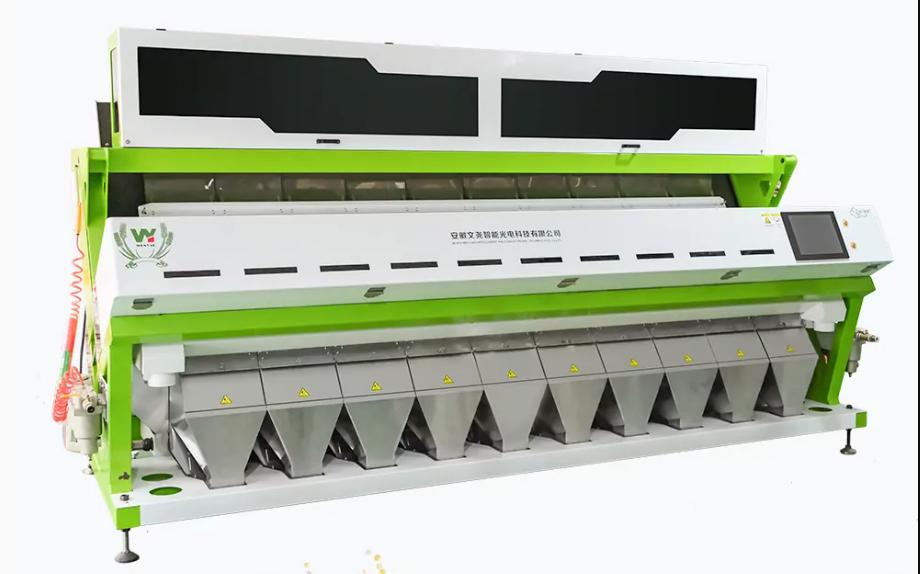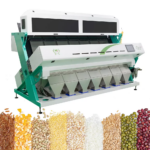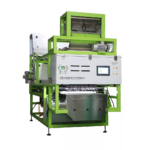Welcome to the Tahoe Lecture Hall! This online training class is designed for primary maintenance engineers of color sorters. Building on the theoretical knowledge from our last lesson, this session is practical. We will cover two main topics:
- Working Principle of Color Sorter
- Main Mechanical Structure and Function
To illustrate these concepts, we will use the TN in 10 Shoots Color Sorter as an example.
Table of Contents
ToggleWorking Principle of a Color Sorter
Understanding the working principle of a color sorter is essential for effective operation and maintenance. Here’s a step-by-step explanation using the TN in 10 Shoots Color Sorter:
Step-by-Step Process:
- Pouring Raw Material into the Feed Hopper
- The process begins by pouring the raw material into the feed hopper.
- Oscillating Feeder Distributes the Raw Material Evenly
- The oscillating feeder ensures that the raw material is evenly distributed across all channels.
- Raw Material Slides Down from Oscillating Feeder to the Trough
- Once distributed, the raw material slides down from the oscillating feeder into the trough.
- Material Moves Through the Trough into the Sorting Room
- The material then travels through the trough into the sorting room, where it is identified, analyzed, and rejection commands are sent if necessary.
- Spray Valve Removes Different Materials and Impurities
- Based on the analysis, the spray valve removes unwanted materials and impurities.
- Final Accept Product and Waste Discharged from the Discharge Hole
- The sorted acceptable products and waste are discharged from the discharge hole.
Ensuring Optimal Performance:
To ensure that the accept products carryover ratio reaches the best effect, you can set up multiple sorting and resorting stages based on different materials. For example, in the 10 Shoots machine:
- Sorting Ratio: 6:3:1
- 6 represents the number of channels for the first sorting.
- 3 represents the number of channels for the second sorting.
- 1 represents the number of channels for the third sorting.
This multi-stage sorting ensures high precision and quality in the final output.
Main Mechanical Structure and Function
After understanding the basic working principle of a color sorter, let’s delve into its main mechanical structure and functions. The color sorter is composed of eight main parts:
- Feed Hopper
- Trough
- Sorting Room
- Ash Cleaning Components
- Pneumatic Trio
- Electronic Control Box
- Dust Suction Device
- Discharging Device
Detailed Breakdown:
- Feed Hopper
- Function: The feeder, located at the top of the hopper, pushes the raw material evenly into the trough.
- Trough
- Function: The trough provides a channel for materials to accelerate and slide, maintaining a single-layer distribution. This ensures materials are in the correct position for effective sorting.
- Components: Leather cover plates and other components are used to adjust the falling posture of the material, preventing bouncing and ensuring smooth flow.
- Sorting Room
- Function: The sorting room is where the magic happens. As the material falls freely through this area, it is:
- Identified and Analyzed: Cameras and imaging systems detect and analyze the material.
- Command Sent: Based on the analysis, commands are sent to remove unwanted materials.
- Components:
- Front and Rear Sorting Rooms: Both are closed, clean environments.
- Camera and Imaging Systems: The front and rear sorting rooms are equipped with cameras and lighting systems that act like eyes and brains, converting images into signals for processing.
- Spray Valve: Acts like hands, removing bad materials based on the commands received.
- Ash Cleaning Components
- Function: Located between the front and rear sorting rooms, these components clean dust and debris that accumulate over time, ensuring the spray valve and sorting mechanisms remain unobstructed for optimal performance.
- Pneumatic Trio
- Function: Controls and adjusts the working pressure of the entire machine and filters water pollution, maintaining consistent operation.
- Electronic Control Box
- Function: Acts as the power supply and electrical control center of the machine, managing all electronic operations and ensuring seamless coordination between components.
- Dust Suction Device
- Function: Similar to a cooker hood, it removes dust generated during the sorting process, especially important when handling materials like peanuts that produce a lot of dust. This keeps the working environment clean and improves separation efficiency.
- Discharging Device
- Function: Separates qualified and unqualified materials, earmarking them for final accept product export and waste export. This ensures that only high-quality products are packaged and sent forward, while waste is efficiently removed.
Conclusion
Understanding both the working principle and the main mechanical structure of a color sorter is crucial for effective operation and maintenance. By familiarizing yourself with each component and its function, you can ensure your color sorter operates smoothly, delivering high-quality sorted products consistently.
Frequently Asked Questions (FAQs)
- Why is the oscillating feeder important in a color sorter machine?
The oscillating feeder ensures that the raw material is evenly distributed across all channels. This uniform distribution is crucial for maintaining consistency and accuracy in the sorting process, leading to high-quality sorted products.
- How does the sorting ratio affect the performance of the color sorter?
The sorting ratio, such as 6:3:1 in the 10 Shoots machine, determines the number of channels dedicated to each sorting stage. A higher ratio in the initial stages ensures that the bulk of impurities are removed early, while subsequent stages refine the sorting, enhancing overall precision and product quality.
- What role does the ash cleaning component play in the color sorter?
The ash cleaning components remove dust and debris that accumulate in the sorting rooms. This prevents the spray valves and other critical parts from becoming blocked, ensuring the machine continues to operate at its best sorting efficiency.














